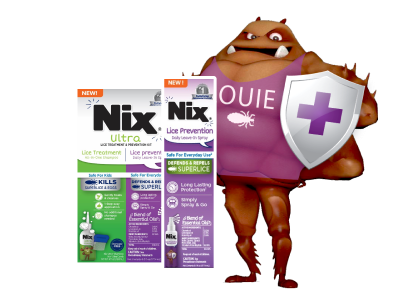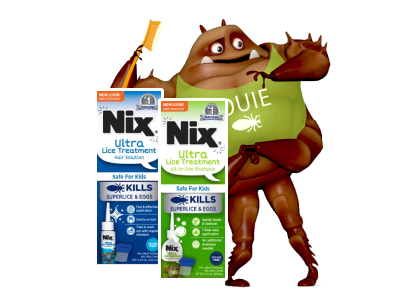
How to Do a Proper Head Lice Check
When there are lice outbreaks at school or your child is returning from a week-long sports tournament or overnight camp, it’s good practice to do a head lice check. If you see your child scratching their head more often or they’re not sleeping well or have become unusually irritable, these could be signs they may have lice. Don’t panic! You will want to do a proper head lice check to confirm. We’ll show you the steps to perform a proper head lice check to help alleviate some unnecessary stress.
How to Check for Lice
Suggested tools or supplies for a head lice check
When you have kids there are certain products, tools and supplies that are helpful to have at home at all times so you can do a head check without notice. Luckily, some of these items are things you might already have around the house for other purposes.
- Tissues or paper towels
- Sealable plastic bag
- An old towel
- Disposable gloves
- Hair clips
- Lice removal comb
- Magnifying glass
- Timer
- Bright light
- Nix® Ultra Lice Removal Kit, Nix® Ultra All-in-One Shampoo or Nix® Ultra Solution
Your mobile phone likely has a light, timer and magnifying app you can use. If you don’t keep lice treatment products on hand, your local store or drugstore should carry Nix® lice treatment products. You can use our Where to Buy online tool to find Nix products near you.
Know how to identify lice
Once you have your supplies ready, you will need to know what lice look like before you start the head lice check.
- Adult lice – Found on the scalp or hair, adult lice have 6 legs with claws, are about the size of a sesame seed, and are grayish-white or tan.
- Nymphs – These baby lice are smaller than adults (about pinhead size) and have a dull yellow shell.
- Nits – Lice eggs are tiny (like a knot in thread) and can be white, yellow or tan.
- Lice are so tiny, it’s easy to think what you see are merely skin flakes (dandruff) or dirt. Dandruff flakes and dirt move pretty easily though, and lice eggs and nymphs don’t. Watch the Nix® video on how to check and identify lice.
Steps for a head lice check
Once you’ve gathered your tools and supplies and know what lice look like, you are ready to start the head check. Follow these steps:
- Sit your child in a chair that is not upholstered. This way if lice fall off the head, they are more likely to not find another host and die. You also want to be in an area where you can easily move around the chair to inspect all sides of the scalp.
- Shine a bright light on your child’s head, a flashlight, or even a lighted magnifying glass to better find these tiny creatures.
- Gloves aren’t necessary but if you prefer, they are fine to use along with a lice removal comb to separate the hair into sections. If the hair is long enough, put hair you are not yet examining in hair clips.
- Start at the base of the neck, use the comb to search for lice and look through your magnifying glass to spot tiny lice or nits. Check behind the ears as well, since lice like to stay in warm places.
- Look for adult lice, which may be crawling on the scalp, and eggs, which will be in a fixed position on the hair shaft up to a quarter-inch away from the scalp. If you see something on the hair, try to move it. If it moves easily, it’s more likely to be dandruff since nits stick to the hair shaft.
- After each stroke or section, wipe the comb on the tissue or paper towel and see if any lice come off.
- If you find lice, treat with a safe and effective head lice treatment, like Nix® Ultra, and follow the instructions on the box. See below for further information on what to do if you find lice or watch our How to Use Nix Ultra Lice Treatment Solution video or How to use Nix Ultra Lice Treatment All-in-One Shampoo video.
If you do find lice: Remove lice and nits using a lice removal comb (included with Nix® treatment products) and place them on the tissue and then into the sealable plastic bag, which you will throw away when you are finished. The Nix® Ultra Lice Removal Kit, which we mentioned in the supplies list above, has Nix Ultra® Lice Treatment Hair Solution in it. Use that—or another lice treatment product—as directed to kill any remaining lice and lice eggs.
Wash all bedding (sheets, pillowcases, comforters, blankets, etc.) and clothing that your child used in the past few days. This includes any stuffed animals they slept with. Wash these items in very hot water (130°F [54.4°C]), then put them in the hot cycle of the dryer for at least 20 minutes. Anything that cannot be washed (or not washed in hot water) should be dry cleaned or put in airtight bags for two weeks to kill any lice or nits.
Anything else, like sofas, chairs, carpets, or car seats, that are shared among the family and cannot be washed, can be sprayed with Nix® Lice Killing Spray (a bottle is included the Nix® Ultra Lice Removal Kit as well).
It is important to recheck hair in 7 days. If lice or nits are still present, another round of treatment and combing is necessary.
You and your other family members should all be checked and if no lice are present, you can use Nix® Lice Prevention Daily Leave-In Spray as well. This spray-and-go solution can be used in hair each day during lice outbreaks in school or camp or to help protect other family members when one child has lice. Once lice are no longer present on your child, you can begin to use Nix Lice Prevention Daily Leave-In spray to help prevent future outbreaks.
If you do not find lice: Keep checking your child every few days for 7 days for evidence of lice. Use our lice prevention tips in 7 Tips to Prevent Lice in School, Sports and Summer Camp, and our Head Lice FAQs. You can also check our How to Prevent Lice video for helpful tips.
How to check for lice on yourself
Checking for lice on yourself is not easy. If you can, enlist a family member, friend or doctor to help. If you’re the only adult in the house and need to check, set up at least two mirrors facing your scalp and each other to help you see. Check in a bathroom or somewhere where there is bright light. Follow the same steps above, using a comb to help separate hair strands and see lice more easily.
With lice, the more you know, the easier it is to identify, treat and prevent lice.



